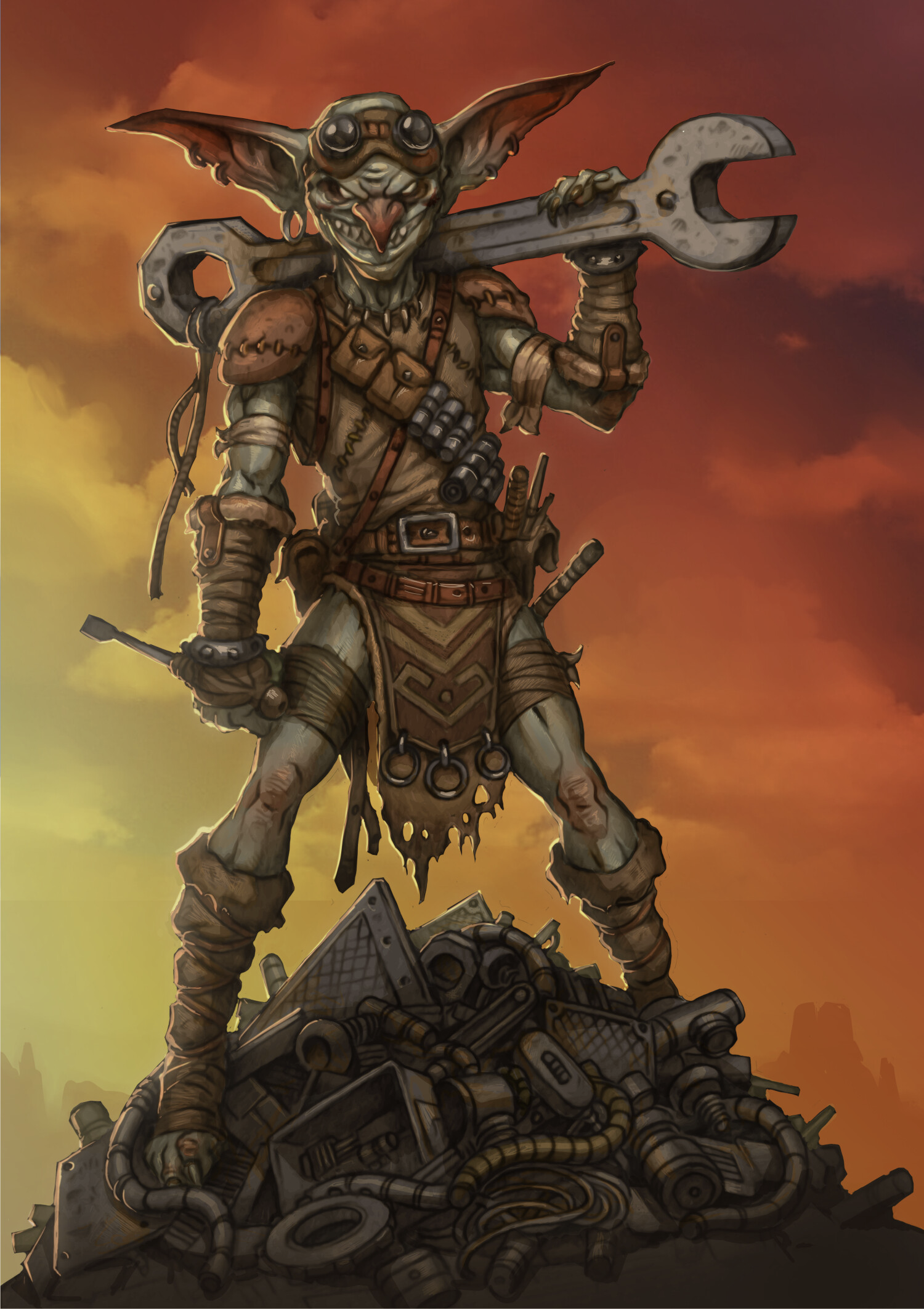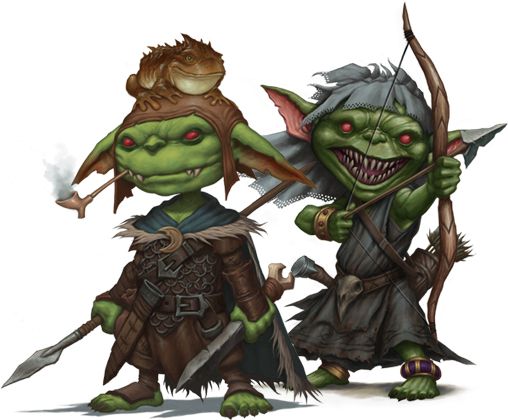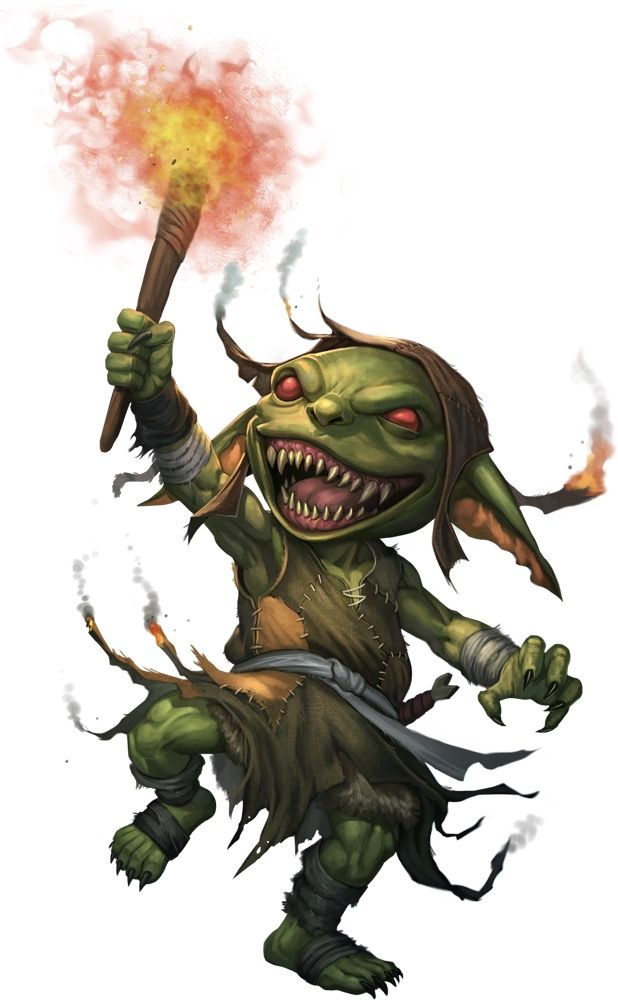Goblin
Shadow Kind
This race originates from the Shadow Realm. However, they mature quickly and thus can easily establish new warrens where ever they find themselves. Because of this, there are warrens that are comprised entirely of individuals who were born within the Mundane world.The Mundane Goblin
There are those goblins that have adapted well to the Mundane world. Many of these were the strange, overly smart goblins from the Shadow Realm that found they fit in better here in the Mundane world where they were no longer required to live such a cruel life. Others are goblins that have been raised within the Mundane world and have never known a Warren in the earth. Either way, these goblins have found their way in this new world by living on the fringe. They gather in small groups and live with other Shadow Kind or work for those who can see past the veil. Either way, they make use of their nimble hands. They have found that they are generally rather good at making things. They are also well suited for sneaking and hiding which makes them excellent at hiding within the human cities and living off what the human throw away.Basic Information
Ecology and Habitats
There are those goblins within the Mundane world that have continued just as they had been doing in the Shadow Realm. They have built warrens within the ground that emulate those in the Shadow Realm. They have done their best to do as they always have done. These goblins are cruel and nasty creatures that live up to the reputation that their race has earned.
Beast Masters and Slave Drivers
Goblins know they are a weak, unsophisticated race that can be easily dominated by bigger, smarter, more organized, more ferocious, or more magical creatures. Their god was conquered by Maglubiyet, after all, and now when the Mighty One calls for it, even their souls are forfeit. It is this realization that drives them to dominate other creatures whenever they can — for goblins, life is short. Goblins seek to trap and enslave any creatures they encounter, but they flee from opposition that seems too daunting. For miles around their lair, they employ pit traps, snares, and nets to catch the unwary, and when their hunting patrols encounter other beings, they always look for ways to capture their foes instead of killing them. Goblins that run up against the fringes of a society first test its defenses by stealing objects, and if these crimes go unpunished, they begin stealing people. Enslaved creatures receive the worst treatment the goblins can dish out while still getting decent performance out of the slaves. But humanoids and monsters that are especially capable or that provide unusual services find themselves treated like favored (though occasionally abused) pets. Virtually any kind of creature that can be browbeaten into service might be found with a goblin tribe, but rats and wolves are nearly always present. Both have lived in concert with goblins for at least as long as humans have worked with dogs and horses, and in goblin society those two animals serve similar purposes. Family Matters A goblin tribe is organized in a four-tiered caste system made up of lashers, hunters, gatherers, and pariahs. The status of every family in the tribe is based on its importance to the tribe’s survival. Families that belong to the higher-ranking castes keep their status by not sharing their knowledge and skills with other families, while those in the lower castes have little hope of escaping their plight. Outsiders who don’t understand the goblins’ social system are sometimes surprised by how different castes interact with them. A single human warrior might frighten away a dozen gatherers, only to be shocked when two hunters viciously attack. A captured group of invaders might hang in a net while dozens of goblins pass by and pay them no heed until a group of gatherers shows up.Lashers.
The closest thing a goblin tribe has to nobility is the caste of lashers — families of goblins trained in the ways of battle, and also possessed of key skills such as strategy, trap-building, beast taming, mining, smelting, forging, and religion. If the tribe has any spellcasters, this caste includes them. Lashers follow the lead of the tribe’s boss, and enforce their will on other goblins with whips.Hunters.
The families of goblins that are skilled in the use of weapons but not privy to any other special knowledge have the second highest status in the tribe. Hunters are often the best wolf riders and know the most about the territory farthest from the tribe’s lair. These individuals hunt game in peaceful times, and in combat they serve as scouts, foot soldiers, and cavalry.Gatherers.
Families in the second lowest caste are responsible for getting food from the surrounding area, taking what’s naturally available or stealing whatever they can. Gatherers also do the little amount of farming of which goblins are capable and are charged with checking traps for captured people or beasts. Gatherers aren’t usually armed with weapons more deadly than a sling or a knife, but they frequently carry nets, caltrops, lassos, and nooses on poles for controlling captured creatures. These goblins cook for the tribe, and in times of war they are also responsible for making poison. Gatherers, and the pariahs beneath them, greatly fear for their lives in battle, believing that the lashers and the hunters have special knowledge of how to survive. It is the members of the lower castes that give goblins their reputation for cowardice.Pariahs.
Some goblin families are the lowest of the low, composed of the most dimwitted, least educated, and weakest goblins. They get the worst jobs: mucking out animal pens, cleaning up after other goblins, and doing any hard labor such as digging mines. If the goblin tribe has slaves to do some of this work, the pariah families enjoy the opportunity to supervise and dominate such creatures, which have no status at all.Status Symbols
Goblins love symbols of authority, and thus the tribe’s boss often has such trappings wherever he or she goes. Such a symbol can take a typical form, perhaps a crown or a throne, but also can be a more distinctive objects like a high-backed wolf saddle or colorful boots. The castes in a tribe also adopt symbols to indicate membership or kinship, but the symbols used are rarely the same between different tribes and often make little sense to other creatures. Some possible status symbols are given in the Status Symbols table. A caste or a boss might display more than one of these items.Booyahgs
Spellcasters of any sort among the goblins are rare. Goblins typically lack the intelligence and patience needed to learn and practice wizardry, and they fare poorly even when given access to the necessary training and knowledge. Sorcerers are less prevalent among them than in many other races, and Khurgorbaeyag seems to dislike sharing his divine power with his followers. And although many goblins would readily offer anything to have the abilities of a warlock, the patrons that grant such power know a goblin is unlikely to be able to uphold its end of any bargain. Even when a goblin is born with the ability to become a spellcaster, the knowledge and talent necessary to carry on the tradition rarely persists for more than a couple of generations. Because they have so little experience with magic, goblins make no distinction between its forms. To them all magic is “booyahg,” and the word is part of the name they give to any of its practitioners. A goblin with access to booyahg becomes a member of the lashers and can often rise to the role of boss.Booyahg Caster.
This goblin served under a hobgoblin wizard, stole a look at its master’s spellbook, and learned a little wizardry by aping the gestures and words it remembered. The goblin can cast a randomly determined 1st-level wizard spell once per day. Intelligence is its spellcasting ability. Booyahg Wielder. This goblin found a magic item (a necklace of fireballs, a circlet of blasting, or the like) and learned how to use it.Booyahg Whip.
Khurgorbaeyag saw fit to gift this goblin with powers that enable it to dominate others. The goblin has 1d3 other goblins that slavishly obey its orders.Booyahg Slave.
This goblin warlock serves a patron who can extract payment in flesh if the goblin doesn’t do as promised. Often this patron is a coven of hags serving as the tribe’s boss, a fiend that has made its way into the world, or an undying lord such as a lich or a vampire. (For more information on undying lord patrons, see the Sword Coast Adventurer’s Guide.) Use one of the warlock stat blocks in appendix B to represent this goblin, adding darkvision and the Nimble Escape traits common to all goblins.Booyahg Booyahg Booyahg.
This goblin is a sorcerer with the wild magic origin whose every casting, including cantrips, is accompanied by a wild magic surge. Use the mage stat block in the Monster Manual to represent this goblin, adding darkvision and the Nimble Escape traits common to all goblins. Each time the goblin casts a spell, there is an accompanying surge of wild magic; roll on the Wild Magic Surge table in the Player’s Handbook to determine the wild magic effect.Additional Information
Perception and Sensory Capabilities
Darkvision
You can see in dim light within 60 feet of you as if it were bright light, and in darkness as if it were dim light. You can’t discern color in darkness, only shades of gray.Fury of the Small
When you damage a creature with an attack or a spell and the creature’s size is larger than yours, you can cause the attack or spell to deal extra damage to the creature. The extra damage equals your level. Once you use this trait, you can’t use it again until you finish a short or long rest.Nimble Escape
You can take the Disengage or Hide action as a bonus action on each of your turns.
Origin/Ancestry
Shadow Realm
Related Organizations







Comments